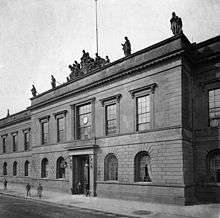Prussian Academy of Arts

The Prussian Academy of Arts (German: Preußische Akademie der Künste) was an art school set up in Berlin, Brandenburg, in 1694/1696 by prince-elector Frederick III, in personal union Duke Frederick I of Prussia, and later king in Prussia. It had a decisive influence on art and its development in the German-speaking world throughout its existence. It dropped 'Prussian' from its name in 1945 and was finally disbanded in 1955 after the 1954 foundation of two separate academies of art for East Berlin and West Berlin in 1954. Those two separate academies merged in 1993 to form Berlin's present-day Academy of Arts.
After the Accademia dei Lincei in Rome and the Académies Royales in Paris, the Prussian Academy of Art was the oldest institution of its kind in Europe, with a similar foundational mission to other royal academies of that time, such as the Real Academia Española in Madrid, the Royal Society in London, the Royal Swedish Academy of Sciences in Stockholm or the Russian Academy of Sciences in St Petersburg. For an extended period of time it was also the German artists' society and training organisation, whilst the Academy's Senate became Prussia's arts council.
Name changes
- 1696–1704 Academie der Mahl-, Bild- und Baukunst (Academy of the Art of Painting, Pictorial Art and Architecture)
- 1704–1790 Königlich-Preussische Akademie der Künste und mechanischen Wissenschaften (Royal Prussian Academy of Arts and Mechanical Sciences)
- 1790–1809 Königliche Akademie der bildenden Künste und mechanischen Wissenschaften zu Berlin (Royal Academy of Visual Arts and Mechanical Sciences at Berlin)
- 1809–1875 Königlich Preussische Akademie der Künste (Royal Prussian Academy of Arts)
- 1875–1882 Königlich Preussische Akademie der Künste zu Berlin (Royal Prussian Academy of Arts at Berlin)
- 1882–1918 Königliche Akademie der Künste zu Berlin (Royal Academy of Arts at Berlin)
- 1918–1926 Akademie der Künste zu Berlin (Academy of Arts at Berlin)
- 1926–1931 Preußische Akademie der Künste zu Berlin (Prussian Academy of Arts at Berlin)
- 1931–1945 Preussische Akademie der Künste (Prussian Academy of Arts)
History
Students and professors
Emil Fuchs studied at the Academy under Fritz Schaper and Anton von Werner, shortly before 1891.[1][2]
Käthe Kollwitz became the first woman elected to the Prussian Academy, but with the coming to power of Adolf Hitler in 1933 she was expelled because of her beliefs and her art.
Otto Geyer studied there from 1859-1864.
Sculptor Wilhelm Neumann-Torborg studied at the academy from 1878 until 1885, under Otto Knille and Fritz Schaper.[3] In 1885, he won the Academy's Rome Scholarship for his thesis, "The Judgment of Paris".[3]
References
- ↑ See Commons category: Fritz Schaper
- ↑ Quoted on Tate website: Ronald Alley, Catalogue of the Tate Gallery's Collection of Modern Art other than Works by British Artists, Tate Gallery and Sotheby Parke-Bernet, London 1981, pp.227-8
- 1 2 Cécile Zachlod. "Das Armenpflegedenkmal von Elberfeld im Wandel der Denkmalkultur um 1900" (PDF). Bergischer Geschichtsverein, Abt. Wuppertal. Retrieved 30 November 2015.
|